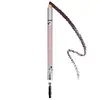Benefit Cosmetics The POREfessional Face Primer Versus Benefit Cosmetics Gimme Brow+ Volumizing Pencil
What's inside
What's inside
 Key Ingredients
Key Ingredients

 Benefits
Benefits

No benefits
 Concerns
Concerns

 Ingredients Side-by-side
Ingredients Side-by-side

Cyclopentasiloxane
EmollientDimethicone
EmollientDimethicone/Vinyl Dimethicone Crosspolymer
Skin ConditioningIsononyl Isononanoate
EmollientSilica
AbrasiveDimethicone Crosspolymer
Emulsion StabilisingIsododecane
EmollientPhenoxyethanol
PreservativePolymethyl Methacrylate
CI 77891
Cosmetic ColorantCyclohexasiloxane
EmollientTocopheryl Acetate
AntioxidantParfum
MaskingMica
Cosmetic ColorantCI 77492
Cosmetic ColorantLimonene
PerfumingCI 77491
Cosmetic ColorantCI 77499
Cosmetic ColorantTriethoxycaprylylsilane
BHT
AntioxidantCyclopentasiloxane, Dimethicone, Dimethicone/Vinyl Dimethicone Crosspolymer, Isononyl Isononanoate, Silica, Dimethicone Crosspolymer, Isododecane, Phenoxyethanol, Polymethyl Methacrylate, CI 77891, Cyclohexasiloxane, Tocopheryl Acetate, Parfum, Mica, CI 77492, Limonene, CI 77491, CI 77499, Triethoxycaprylylsilane, BHT
Mica
Cosmetic ColorantSilica
AbrasiveDimethicone/Divinyldimethicone/Silsesquioxane Crosspolymer
HumectantPolymethyl Methacrylate
Synthetic Fluorphlogopite
Pentylene Glycol
Skin ConditioningPEG-10 Dimethicone
Skin ConditioningCaprylyl Glycol
EmollientTriethyl Citrate
MaskingMagnesium Aluminum Silicate
AbsorbentPhenylpropanol
MaskingMethylpropanediol
SolventAlgin
MaskingDehydroacetic Acid
PreservativeEthylhexylglycerin
Skin ConditioningSodium Polyacrylate
AbsorbentCitric Acid
BufferingDipropylene Glycol
HumectantGlyceryl Caprylate
EmollientCellulose
AbsorbentBenzyl Alcohol
PerfumingTocopherol
AntioxidantCI 19140
Cosmetic ColorantCI 42090
Cosmetic ColorantCI 77007
Cosmetic ColorantCI 77163
Cosmetic ColorantCI 77491
Cosmetic ColorantCI 77492
Cosmetic ColorantCI 77499
Cosmetic ColorantCI 77742
Cosmetic ColorantCI 77891
Cosmetic ColorantMica, Silica, Dimethicone/Divinyldimethicone/Silsesquioxane Crosspolymer, Polymethyl Methacrylate, Synthetic Fluorphlogopite, Pentylene Glycol, PEG-10 Dimethicone, Caprylyl Glycol, Triethyl Citrate, Magnesium Aluminum Silicate, Phenylpropanol, Methylpropanediol, Algin, Dehydroacetic Acid, Ethylhexylglycerin, Sodium Polyacrylate, Citric Acid, Dipropylene Glycol, Glyceryl Caprylate, Cellulose, Benzyl Alcohol, Tocopherol, CI 19140, CI 42090, CI 77007, CI 77163, CI 77491, CI 77492, CI 77499, CI 77742, CI 77891
 Reviews
Reviews

Ingredients Explained
These ingredients are found in both products.
Ingredients higher up in an ingredient list are typically present in a larger amount.
Ci 77491 is also hydrated iron III oxide. It's sole purpose is to give a red/pink hue to products.
Iron III oxides are classified as inorganic chemicals for coloring.
Synthetically created Ci 77491 is considered safer than those naturally found. This is because the synthetically created version may contain less impurities. Iron oxides are generally non-toxic and non-allergenic.
Learn more about CI 77491Ci 77492 is also hydrated iron III oxide. It's sole purpose is to give a yellow hue to products.
Iron III oxides are classified as inorganic chemicals for coloring.
Synthetically created Ci 77492 is considered safer than those naturally found. This is because the synthetically created version may contain less impurities. Iron oxides are generally non-toxic and non-allergenic.
Learn more about CI 77492Ci 77499 is also hydrated iron III oxide. It is created from mixing red and black iron oxides. This helps give shades of darkness to a product.
Iron III oxides are classified as inorganic chemicals for coloring.
Ci 77891 is a white pigment from Titanium dioxide. It is naturally found in minerals such as rutile and ilmenite.
It's main function is to add a white color to cosmetics. It can also be mixed with other colors to create different shades.
Ci 77891 is commonly found in sunscreens due to its ability to block UV rays.
Learn more about CI 77891Mica is a naturally occurring mineral used to add shimmer and color in cosmetics. It can also help improve the texture of a product or give it an opaque, white/silver color.
Serecite is the name for very fine but ragged grains of mica.
This ingredient is often coated with metal oxides like titanium dioxide. Trace amounts of heavy metals may be found in mica, but these metals are not harmful in our personal products.
Mica has been used since prehistoric times throughout the world. Ancient Egyptian, Indian, Greek, Roman, Aztec, and Chinese civilizations have used mica.
Learn more about MicaThis ingredient is also known as PMMA. It is a polymer microsphere, composed of tiny, perfectly spherical particles formed from repeating units.
In cosmetics, PMMA is mainly used to give a soft or blurring effect. The transparent particles are able to scatter light and help reduce the appearance of fine-lines and imperfections.
PMMA is also able to enhance the texture of products by add a smooth feel.
Learn more about Polymethyl MethacrylateSilica, also known as silicon dioxide, is a naturally occurring mineral. It is used as a fine, spherical, and porous powder in cosmetics.
Though it has exfoliant properties, the function of silica varies depending on the product.
The unique structure of silica enhances the spreadability and adds smoothness, making it a great texture enhancer.
It is also used as an active carrier, emulsifier, and mattifier due to its ability to absorb excess oil.
In some products, tiny microneedles called spicules are made from silica or hydrolyzed sponge. When you rub them in, they lightly polish away dead skin layers and enhance the penetration of active ingredients.
Learn more about Silica